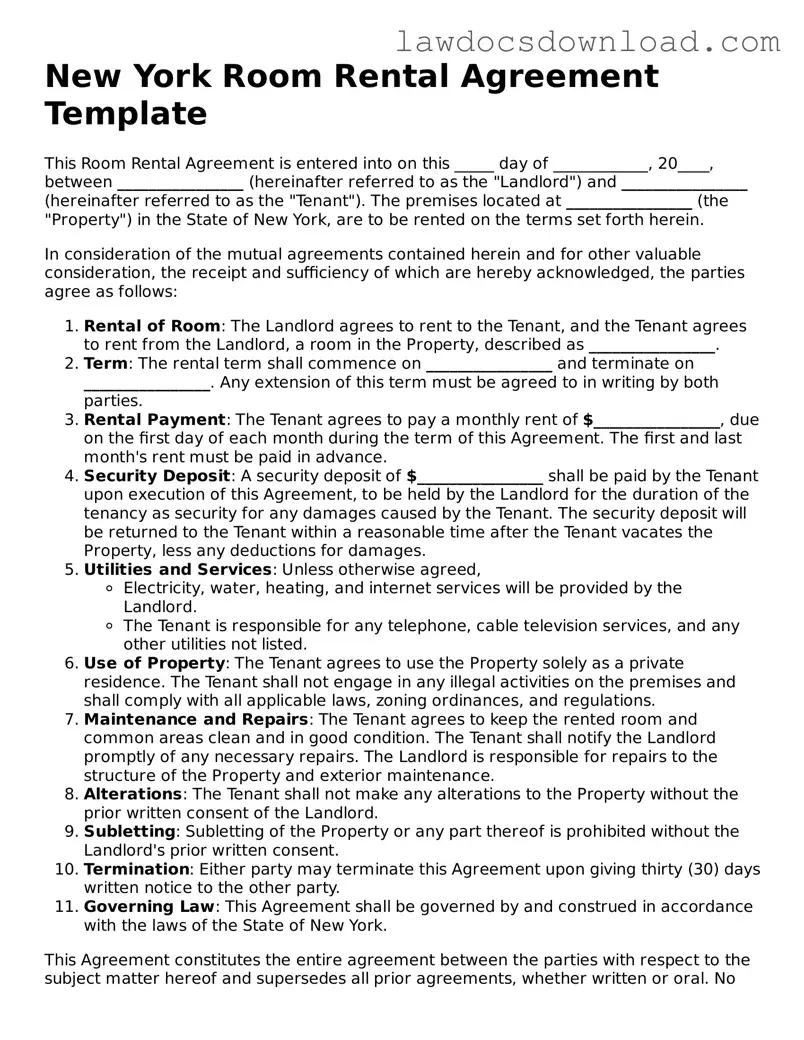The New York Room Rental Agreement form shares similarities with a Residential Lease Agreement, essentially serving the same primary purpose of establishing the terms under which a tenant may occupy a residential space. However, a Room Rental Agreement is more specific, detailing an arrangement where only a single room within a property is being rented, whereas a Residential Lease Agreement typically encompasses the rental of an entire dwelling. Both documents outline details such as payment terms, lease duration, and obligations of both parties but are distinguished by the scope of the leased space.
Similar to a Sublease Agreement, the Room Rental Agreement allows for the rental of a portion of a living space. A Sublease Agreement is used when a tenant, holding a lease to a property, decides to rent out part or all of the property to another party. Both agreements involve the tenant role, but the Room Rental Agreement is specifically designed for the rental of a room by the property's primary leaseholder, while a Sublease Agreement can apply to any portion of the leased property or the entire thing.
The Room Rental Agreement also has parallels with a Lodger Agreement. Both types of agreements are concerned with the rental of a part of a property. However, a Lodger Agreement is typically used when the owner lives on the premises and is renting out part of their home to a lodger. This type of agreement underlines the homeowner's retention of control over the property, which is a subtle but important distinction from the typically more equal standing of parties in a Room Rental Agreement.
A Co-Tenancy Agreement is another document related to a Room Rental Agreement. It is commonly used when two or more individuals decide to rent a property together. Both documents deal with shared living arrangements, but a Co-Tenancy Agreement involves all tenants having an equal partnership in the entire property's lease. In contrast, a Room Rental Agreement is usually between the property's primary tenant or owner and an individual renting a room.
The similarities between a Room Rental Agreement and a Month to Month Lease are present in the flexible nature of both agreements. A Month to Month Lease offers a short-term arrangement that either party can terminate with proper notice, usually 30 days. This flexibility is also a feature of many Room Rental Agreements, allowing for easy adaptation to the needs of the room renter and the principal tenant or property owner.
A Property Management Agreement is another document that, while distinct, shares a foundational similarity with a Room Rental Agreement in the aspect of property rental management. Property Management Agreements are contracts between a property owner and a management company or individual tasked with managing the property. Though not involving the direct rental of space to a tenant, it involves the delegation of authority to oversee rentals and, in some cases, to execute rental agreements such as Room Rental Agreements on behalf of the owner.
Lastly, the House Rules document, often an addendum to a Room Rental Agreement, provides a detailed list of guidelines for conduct within the rented space. While not a stand-alone rental agreement, the House Rules document complements a Room Rental Agreement by specifying acceptable behaviors, responsibilities, and restrictions for the tenant occupying a room. This ensures that all parties have clear expectations about living arrangements, contributing to a harmonious shared living environment.
